![[Updated] The Fundamentals of Creating Dynamic Podcast Feeds for 2024](https://thmb.techidaily.com/5b911fc4e119075c845447b8b1130601d398b21b169f3541bab98402d648f2f7.jpg)
[Updated] The Fundamentals of Creating Dynamic Podcast Feeds for 2024

The Fundamentals of Creating Dynamic Podcast Feeds
If you’ve started creating content for your podcast and want to increase your listener base or make your podcast easily accessible to audiences who enjoy your show, an RSS feed is the solution.
With RSS Feed, your podcast show can reach more listeners, and your audience can easily find your podcast show on any platform. So, if you’re looking to create podcast RSS feeds but don’t know how to go about it, this article will walk you through the simple steps to help you get the job done quickly and easily. So, keep reading.
- Method 1: Create an RSS feed with hosting platforms
- Method 2: Create an RSS feed without a hosting platform
- Method 3: Create your own exclusive RSS feed
Part 1. What Is an Podcast RSS Feed?
RSS, Really Simple Syndication, has been around for quite a long time (since 1999), and it was introduced to allow internet users to stay connected with their favorite websites. In other words, it’s used to subscribe to news websites, emails, blogs, podcasts, etc. It is just a simple link looking like this:
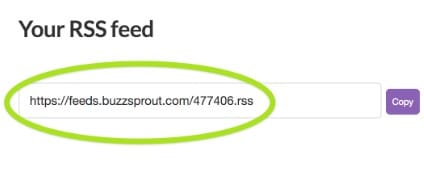
Your Podcast RSS feed makes the information about your podcast quickly accessible on various podcast directories, like Apple Podcast and Spotify. Yes, it holds the information about your podcast show and its episodes. So, whenever you create a new episode on the hosting website, it automatically updates it to podcast directories in real-time, thus making it accessible to listeners at their convenience.
Ultimately, an RSS feed saves you the stress of manually uploading new episodes of your podcast to various platforms! An RSS feed could also be referred to as;
- RSS channel
- Newsfeed
- RSS stream
- Web feed
Part 2. When to Use an RSS Feed
The concept of an RSS feed is pretty simple. It is what bridges the gap between your content and internet users. It means it’s not only helpful to podcasters but also to websites, blogs, etc.
As we all know, the average internet user won’t always have the time to visit your website or podcast channel to check new posts. So, by using RSS Feed on your website, podcast channel, email, etc., it’ll be easy for them to stay updated with every new content you publish.
RSS feed is necessary for any podcaster looking to thrive in the industry, and it’s the only way to allow your target audience to access your content quickly.
Part 3. How Do I Find the RSS Feed for My Podcast?
If you’ve uploaded podcasts to a hosting site and you’re wondering where to find the podcast RSS feed links, it’s pretty simple. You don’t need to do anything, as your RSS Feed will be automatically created once you set up your account on the platform.
Usually, the RSS feed can be found in Settings or the Directories tab. But, of course, that varies according to different hosting sites. So, we take buzzsprout as an example to show you how to get the RSS feed.
Step1 Open your podcast hosting website and navigate the Directories section. Then, locate any section tagged as Feed.
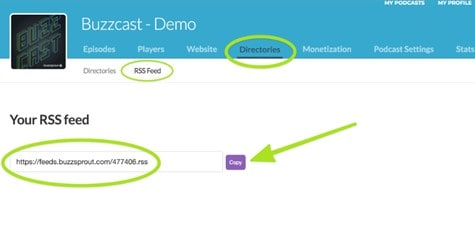
Step2 Click on the Feed button. You should see the podcast RSS feed. You can easily copy it from there.
Part 4. How To Create an RSS Feed for a Podcast?
However, there is also a case that if you use a self-hosted website for podcasting, you’ll require a plugin to generate your podcast RSS feeds. You can’t use it as it’ll include other blog content instead of the podcast, although your website might have its own RSS feed,
Then it’s high time to create a podcast RSS feed. Nevertheless, the process depends on whether you’re using a hosting service or not. Read on to find out how to create an RSS feed with or without a hosting platform;
Method 1: Create an RSS feed with hosting platforms
As mentioned, once you create an account with a podcast hosting website, your podcast RSS Feed will be automatically created. So you just need to complete your account setup, and once you publish a new podcast episode, you can find the RSS Feed in the relevant section of the podcast hosting platform.
We used the Castos hosting website to generate a podcast RSS Feed in the steps below;
Step1 Visit Castos website and set up an account with them.
Step2 Create a new podcast episode and fill in all necessary details in the relevant boxes.
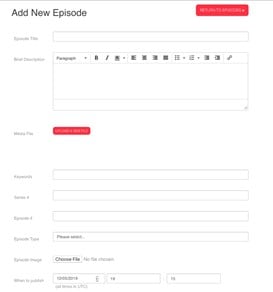
Step3 Navigate to the Podcast Setting area and provide your podcast information, such as Title, Description, Cover art, etc. Afterward, click the relevant button to proceed.
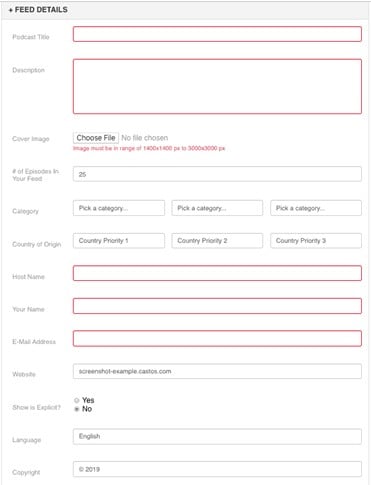
Step4 Once you successfully save your podcast details and upload the new episode, navigate to the Dashboard and locate your Podcast RSS Feed in the Distribution tab.

Method 2: Create an RSS feed without a hosting platform
Since the native RSS Feed of a self-hosted website usually contains blog article content, which is not needed in a podcast RSS Feed, you need a plugin like Powerpress to generate your podcast RSS feed.
The PowerPress plugin allows you to generate RSS feed containing only your podcast audio once you publish new content on your website. The following steps explain the process of creating an RSS feed without a hosting platform;
Step1 Open WordPress and log in to the backend of your WordPress website. Then, select Plugins from the left side and click Add New.
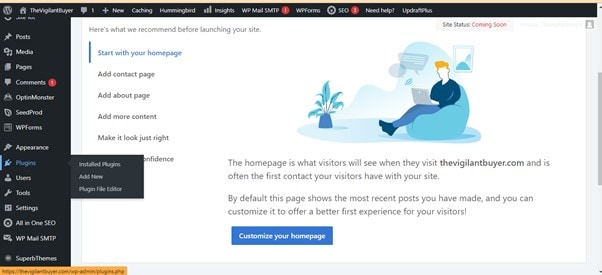
Step2 Search Powerpress plugin and click the Install button next to “PowerPress Podcasting Plugin by Bluburry. After the installation, activate the plugin.
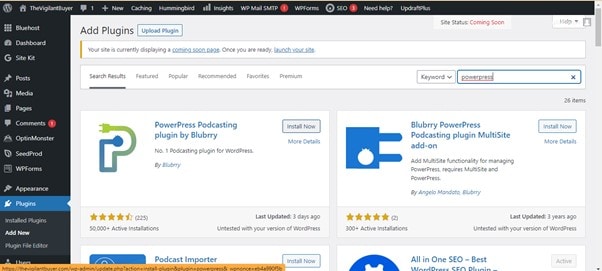
Step3 Once you install and activate the PowerPress plugin, it should appear at the bottom of the left sidebar. Click on it and select Settings.
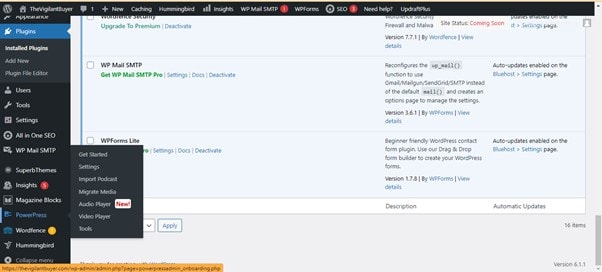
Step4 Click Feed, and you’ll see your RSS Feed link. Also, you can adjust settings for your podcast from this page. It’s as simple as that!
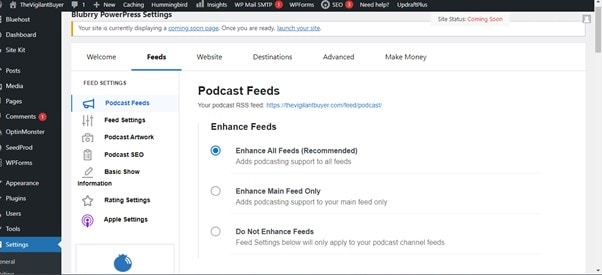
Method 3: Create your own exclusive RSS feed
You can also create your podcast RSS feed without a hosting platform or a self-hosted website. The RSS website can be accessed, and the process is pretty simple. See how this works below;
Step1 Visit RSS.com and sign up for an account for free.
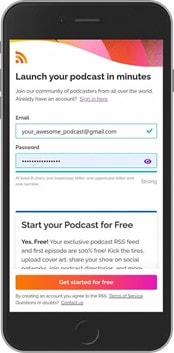
Step2 Confirm the email address you used to sign up for an account. Then, click New Podcast.

Step3 On the new page, enter the Title, Description, and RSS address feed address for your podcast.
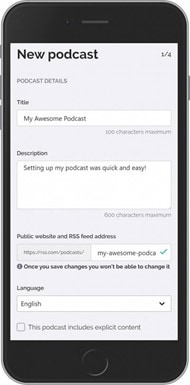
Step4 Add your author details, podcast categories, and podcast cover art on the new page. Then, click Save and Finish. Afterward, click the “RSS Feed” button and copy your podcast’s RSS feed to submit it on any platform you like.
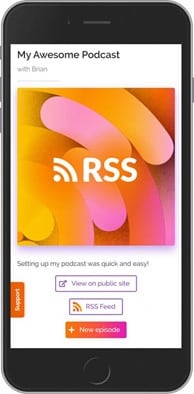
Having discussed all, you need to know how to create an RSS Feed for podcasts. Then, you can choose the best method to upload podcasts right now.
Part 5. Hot FAQs on Podcast RSS Feeds
Besides, we gathered some popular answers to some frequently asked questions from online users that you should know.
1. Does a podcast RSS feed cost?
You don’t need a dime to generate an RSS feed for your podcast. It’s 100% free!
2. Where can I distribute my podcast?
Various platforms you can distribute your podcast to include;
- Spotify
- Apple Podcast
- Google Podcast
- Bluburry
- Pobean
- Castbox
- Podchaser
- TuneIn, etc.
3. What is the difference between a podcast and an RSS?
A podcast is a video or audio show published on the internet, and it’s usually distributed to various podcasting platforms via RSS feed to make it available to subscribers. However, an RSS feed holds information about a podcast show and keeps subscribers up-to-date with every new podcast episode published.
Final Words
Creating a podcast RSS Feed is more straightforward than a ton would ever have imagined. At this point, we believe you’ve successfully set up a podcast RSS feed with a hosting platform, via a self-hosted website, or on your own. Regardless of your method to create the RSS few for your podcast, make sure you follow the steps correctly.
Nevertheless, if you’re looking for a reliable program to record and edit high-quality podcasts, we recommend using Filmora , as it offers the best tools to help you operate efficiently.
Free Download For Win 7 or later(64-bit)
Free Download For macOS 10.14 or later
Part 1. What Is an Podcast RSS Feed?
RSS, Really Simple Syndication, has been around for quite a long time (since 1999), and it was introduced to allow internet users to stay connected with their favorite websites. In other words, it’s used to subscribe to news websites, emails, blogs, podcasts, etc. It is just a simple link looking like this:

Your Podcast RSS feed makes the information about your podcast quickly accessible on various podcast directories, like Apple Podcast and Spotify. Yes, it holds the information about your podcast show and its episodes. So, whenever you create a new episode on the hosting website, it automatically updates it to podcast directories in real-time, thus making it accessible to listeners at their convenience.
Ultimately, an RSS feed saves you the stress of manually uploading new episodes of your podcast to various platforms! An RSS feed could also be referred to as;
- RSS channel
- Newsfeed
- RSS stream
- Web feed
Part 2. When to Use an RSS Feed
The concept of an RSS feed is pretty simple. It is what bridges the gap between your content and internet users. It means it’s not only helpful to podcasters but also to websites, blogs, etc.
As we all know, the average internet user won’t always have the time to visit your website or podcast channel to check new posts. So, by using RSS Feed on your website, podcast channel, email, etc., it’ll be easy for them to stay updated with every new content you publish.
RSS feed is necessary for any podcaster looking to thrive in the industry, and it’s the only way to allow your target audience to access your content quickly.
Part 3. How Do I Find the RSS Feed for My Podcast?
If you’ve uploaded podcasts to a hosting site and you’re wondering where to find the podcast RSS feed links, it’s pretty simple. You don’t need to do anything, as your RSS Feed will be automatically created once you set up your account on the platform.
Usually, the RSS feed can be found in Settings or the Directories tab. But, of course, that varies according to different hosting sites. So, we take buzzsprout as an example to show you how to get the RSS feed.
Step1 Open your podcast hosting website and navigate the Directories section. Then, locate any section tagged as Feed.

Step2 Click on the Feed button. You should see the podcast RSS feed. You can easily copy it from there.
Part 4. How To Create an RSS Feed for a Podcast?
However, there is also a case that if you use a self-hosted website for podcasting, you’ll require a plugin to generate your podcast RSS feeds. You can’t use it as it’ll include other blog content instead of the podcast, although your website might have its own RSS feed,
Then it’s high time to create a podcast RSS feed. Nevertheless, the process depends on whether you’re using a hosting service or not. Read on to find out how to create an RSS feed with or without a hosting platform;
Method 1: Create an RSS feed with hosting platforms
As mentioned, once you create an account with a podcast hosting website, your podcast RSS Feed will be automatically created. So you just need to complete your account setup, and once you publish a new podcast episode, you can find the RSS Feed in the relevant section of the podcast hosting platform.
We used the Castos hosting website to generate a podcast RSS Feed in the steps below;
Step1 Visit Castos website and set up an account with them.
Step2 Create a new podcast episode and fill in all necessary details in the relevant boxes.

Step3 Navigate to the Podcast Setting area and provide your podcast information, such as Title, Description, Cover art, etc. Afterward, click the relevant button to proceed.

Step4 Once you successfully save your podcast details and upload the new episode, navigate to the Dashboard and locate your Podcast RSS Feed in the Distribution tab.

Method 2: Create an RSS feed without a hosting platform
Since the native RSS Feed of a self-hosted website usually contains blog article content, which is not needed in a podcast RSS Feed, you need a plugin like Powerpress to generate your podcast RSS feed.
The PowerPress plugin allows you to generate RSS feed containing only your podcast audio once you publish new content on your website. The following steps explain the process of creating an RSS feed without a hosting platform;
Step1 Open WordPress and log in to the backend of your WordPress website. Then, select Plugins from the left side and click Add New.

Step2 Search Powerpress plugin and click the Install button next to “PowerPress Podcasting Plugin by Bluburry. After the installation, activate the plugin.

Step3 Once you install and activate the PowerPress plugin, it should appear at the bottom of the left sidebar. Click on it and select Settings.

Step4 Click Feed, and you’ll see your RSS Feed link. Also, you can adjust settings for your podcast from this page. It’s as simple as that!

Method 3: Create your own exclusive RSS feed
You can also create your podcast RSS feed without a hosting platform or a self-hosted website. The RSS website can be accessed, and the process is pretty simple. See how this works below;
Step1 Visit RSS.com and sign up for an account for free.

Step2 Confirm the email address you used to sign up for an account. Then, click New Podcast.

Step3 On the new page, enter the Title, Description, and RSS address feed address for your podcast.

Step4 Add your author details, podcast categories, and podcast cover art on the new page. Then, click Save and Finish. Afterward, click the “RSS Feed” button and copy your podcast’s RSS feed to submit it on any platform you like.

Having discussed all, you need to know how to create an RSS Feed for podcasts. Then, you can choose the best method to upload podcasts right now.
Part 5. Hot FAQs on Podcast RSS Feeds
Besides, we gathered some popular answers to some frequently asked questions from online users that you should know.
1. Does a podcast RSS feed cost?
You don’t need a dime to generate an RSS feed for your podcast. It’s 100% free!
2. Where can I distribute my podcast?
Various platforms you can distribute your podcast to include;
- Spotify
- Apple Podcast
- Google Podcast
- Bluburry
- Pobean
- Castbox
- Podchaser
- TuneIn, etc.
3. What is the difference between a podcast and an RSS?
A podcast is a video or audio show published on the internet, and it’s usually distributed to various podcasting platforms via RSS feed to make it available to subscribers. However, an RSS feed holds information about a podcast show and keeps subscribers up-to-date with every new podcast episode published.
Final Words
Creating a podcast RSS Feed is more straightforward than a ton would ever have imagined. At this point, we believe you’ve successfully set up a podcast RSS feed with a hosting platform, via a self-hosted website, or on your own. Regardless of your method to create the RSS few for your podcast, make sure you follow the steps correctly.
Nevertheless, if you’re looking for a reliable program to record and edit high-quality podcasts, we recommend using Filmora , as it offers the best tools to help you operate efficiently.
Free Download For Win 7 or later(64-bit)
Free Download For macOS 10.14 or later
Also read:
- [New] Craft Your Photos in Minutes Learning LunaPic for 2024
- [New] Exquisite Drone Fleet The Pinnacle of Visual Artistry
- [New] From Start to End Mastering the Art of Fading in Pro for 2024
- [New] In 2024, SRS Adjustment Guide Boosting Performance on Both Platforms
- [New] In 2024, The Significance of GoPro's Burst Sequencing Feature
- [New] Photographs Dancing to Musical Rhythms for 2024
- [Updated] 2024 Approved A Beginner's Approach to NVIDIA Screen Capture
- [Updated] 2024 Approved Storytelling Methodologies for the Documentarian
- [Updated] In 2024, Immersive Gaming Unlocked by HTC's Revolutionary VR Headset
- 2024 Approved Concealing Identity Swift Methods for PicScanner
- 2024 Approved Unified Event Tracking Harmonizing Phone & Tablet with PC Zoom
- About Xiaomi 13 Ultra FRP Bypass
- Accelerating Hospital Transfers: Strategies for Expedited Consultations & Superior Treatment Results
- Addressing Windows 11 System Call Failures Quickly
- Choosing the Right Hardware Configuration for Windows Systems: Advice by YL Technologies
- Elevate Your Podcast's Reach with Advanced SEO Strategies for 2024
- Exploring the Leading VR/AR Headsets for 202
- Title: [Updated] The Fundamentals of Creating Dynamic Podcast Feeds for 2024
- Author: Donald
- Created at : 2025-01-09 16:03:13
- Updated at : 2025-01-16 16:11:32
- Link: https://article-posts.techidaily.com/updated-the-fundamentals-of-creating-dynamic-podcast-feeds-for-2024/
- License: This work is licensed under CC BY-NC-SA 4.0.